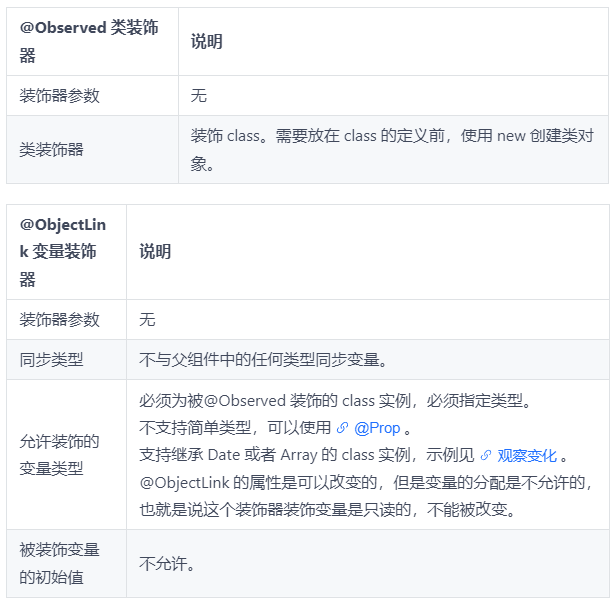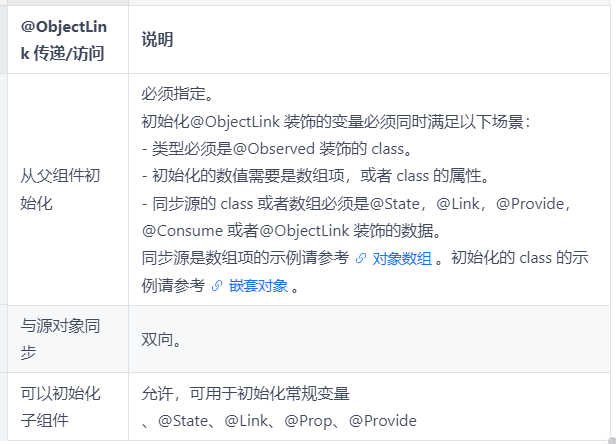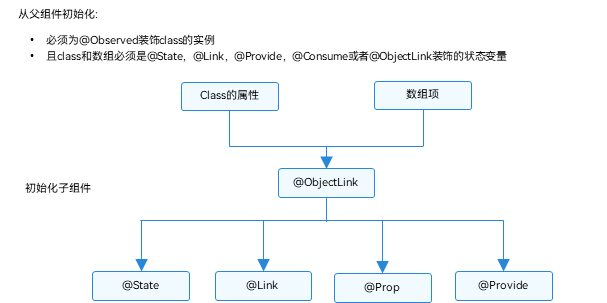上文所述的装饰器仅能观察到第一层的变化,但是在实际应用开发中,应用会根据开发需要,封装自己的数据模型。对于多层嵌套的情况,比如二维数组,或者数组项class,或者class的属性是class,他们的第二层的属性变化是无法观察到的。这就引出了@Observed/@ObjectLink装饰器。
说明:
从API version 9开始,这两个装饰器支持在ArkTS卡片中使用。
概述
@ObjectLink和@Observed类装饰器用于在涉及嵌套对象或数组的场景中进行双向数据同步:
● 被@Observed装饰的类,可以被观察到属性的变化;
● 子组件中@ObjectLink装饰器装饰的状态变量用于接收@Observed装饰的类的实例,和父组件中对应的状态变量建立双向数据绑定。这个实例可以是数组中的被@Observed装饰的项,或者是class object中的属性,这个属性同样也需要被@Observed装饰。
● 单独使用@Observed是没有任何作用的,需要搭配@ObjectLink或者@Prop使用。
限制条件
使用@Observed装饰class会改变class原始的原型链,@Observed和其他类装饰器装饰同一个class可能会带来问题。
装饰器说明

@ObjectLink装饰的数据为可读示例。
1 2 3 4 | // 允许@ObjectLink装饰的数据属性赋值this.objLink.a= ...// 不允许@ObjectLink装饰的数据自身赋值this.objLink= ... |
说明:
@ObjectLink装饰的变量不能被赋值,如果要使用赋值操作,请使用@Prop。
● @Prop装饰的变量和数据源的关系是是单向同步,@Prop装饰的变量在本地拷贝了数据源,所以它允许本地更改,如果父组件中的数据源有更新,@Prop装饰的变量本地的修改将被覆盖;
● @ObjectLink装饰的变量和数据源的关系是双向同步,@ObjectLink装饰的变量相当于指向数据源的指针。禁止对@ObjectLink装饰的变量赋值,如果一旦发生@ObjectLink装饰的变量的赋值,则同步链将被打断。因为@ObjectLink修饰的变量通过数据源(Object)引用来初始化。对于实现双向数据同步的@ObjectLink,赋值相当于更新父组件中的数组项或者class的属性,TypeScript/JavaScript不能实现,会发生运行时报错。
变量的传递/访问规则说明

图1 初始化规则图示

观察变化和行为表现
观察变化
@Observed装饰的类,如果其属性为非简单类型,比如class、Object或者数组,也需要被@Observed装饰,否则将观察不到其属性的变化。
1 2 3 4 5 6 7 8 9 10 11 12 13 14 15 16 17 18 | class ClassA { public c: number; constructor(c: number) { this.c = c; }}@Observedclass ClassB { public a: ClassA; public b: number; constructor(a: ClassA, b: number) { this.a = a; this.b = b; }} |
以上示例中,ClassB被@Observed装饰,其成员变量的赋值的变化是可以被观察到的,但对于ClassA,没有被@Observed装饰,其属性的修改不能被观察到。
1 2 3 4 5 6 7 8 | @ObjectLink b: ClassB// 赋值变化可以被观察到this.b.a = new ClassA(5)this.b.b = 5// ClassA没有被@Observed装饰,其属性的变化观察不到this.b.a.c = 5 |
@ObjectLink:@ObjectLink只能接收被@Observed装饰class的实例,可以观察到:● 其属性的数值的变化,其中属性是指Object.keys(observedObject)返回的所有属性,示例请参考嵌套对象。
● 如果数据源是数组,则可以观察到数组item的替换,如果数据源是class,可观察到class的属性的变化,示例请参考对象数组。
继承Date的class时,可以观察到Date整体的赋值,同时可通过调用Date的接口setFullYear, setMonth, setDate, setHours, setMinutes, setSeconds, setMilliseconds, setTime, setUTCFullYear, setUTCMonth, setUTCDate, setUTCHours, setUTCMinutes, setUTCSeconds, setUTCMilliseconds 更新Date的属性。
1 2 3 4 5 6 7 8 9 10 11 12 13 14 15 16 17 18 19 20 21 22 23 24 25 26 27 28 29 30 31 32 33 34 35 36 37 38 39 40 41 42 43 44 45 46 47 48 49 50 51 52 53 54 55 56 | @Observedclass DateClass extends Date { constructor(args: number | string) { super(args) }}@Observedclass ClassB { public a: DateClass; constructor(a: DateClass) { this.a = a; }}@Componentstruct ViewA { label: string = 'date'; @ObjectLink a: DateClass; build() { Column() { Button(`child increase the day by 1`) .onClick(() => { this.a.setDate(this.a.getDate() + 1); }) DatePicker({ start: new Date('1970-1-1'), end: new Date('2100-1-1'), selected: this.a }) } }}@Entry@Componentstruct ViewB { @State b: ClassB = new ClassB(new DateClass('2023-1-1')); build() { Column() { ViewA({ label: 'date', a: this.b.a }) Button(`parent update the new date`) .onClick(() => { this.b.a = new DateClass('2023-07-07'); }) Button(`ViewB: this.b = new ClassB(new DateClass('2023-08-20'))`) .onClick(() => { this.b = new ClassB(new DateClass('2023-08-20')); }) } }} |
框架行为
1. 初始渲染:
a. @Observed装饰的class的实例会被不透明的代理对象包装,代理了class上的属性的setter和getter方法
b. 子组件中@ObjectLink装饰的从父组件初始化,接收被@Observed装饰的class的实例,@ObjectLink的包装类会将自己注册给@Observed class。
2. 属性更新:当@Observed装饰的class属性改变时,会走到代理的setter和getter,然后遍历依赖它的@ObjectLink包装类,通知数据更新。
使用场景
嵌套对象
以下是嵌套类对象的数据结构。
1 2 3 4 5 6 7 8 9 10 11 12 13 14 15 16 17 18 19 20 21 22 23 24 25 26 27 28 29 30 31 32 33 34 35 36 37 38 39 40 41 42 | // objectLinkNestedObjects.etslet NextID: number = 1;@Observedclass ClassA { public id: number; public c: number; constructor(c: number) { this.id = NextID++; this.c = c; }}@Observedclass ClassB { public a: ClassA; constructor(a: ClassA) { this.a = a; }}@Observedclass ClassD { public c: ClassC; constructor(c: ClassC) { this.c = c; }}@Observedclass ClassC extends ClassA { public k: number; constructor(k: number) { // 调用父类方法对k进行处理 super(k); this.k = k; }} |
以下组件层次结构呈现的是嵌套类对象的数据结构。
1 2 3 4 5 6 7 8 9 10 11 12 13 14 15 16 17 18 19 20 21 22 23 24 25 26 27 28 29 30 31 32 33 34 35 36 37 38 39 40 41 42 | @Componentstruct ViewC { label: string = 'ViewC1'; @ObjectLink c: ClassC; build() { Row() { Column() { Text(`ViewC [${this.label}] this.a.c = ${this.c.c}`) .fontColor('#ffffffff') .backgroundColor('#ff3fc4c4') .height(50) .borderRadius(25) Button(`ViewC: this.c.c add 1`) .backgroundColor('#ff7fcf58') .onClick(() => { this.c.c += 1; console.log('this.c.c:' + this.c.c) }) } .width(300) }}}@Entry@Componentstruct ViewB { @State b: ClassB = new ClassB(new ClassA(0)); @State child : ClassD = new ClassD(new ClassC(0)); build() { Column() { ViewC({ label: 'ViewC #3', c: this.child.c}) Button(`ViewC: this.child.c.c add 10`) .backgroundColor('#ff7fcf58') .onClick(() => { this.child.c.c += 10 console.log('this.child.c.c:' + this.child.c.c) }) } }} |
被@Observed装饰的ClassC类,可以观测到继承基类的属性的变化。
ViewB中的事件句柄:
● this.child.c = new ClassA(0) 和this.b = new ClassB(new ClassA(0)): 对@State装饰的变量b和其属性的修改。
● this.child.c.c = ... :该变化属于第二层的变化,@State无法观察到第二层的变化,但是ClassA被@Observed装饰,ClassA的属性c的变化可以被@ObjectLink观察到。
ViewC中的事件句柄:
● this.c.c += 1:对@ObjectLink变量a的修改,将触发Button组件的刷新。@ObjectLink和@Prop不同,@ObjectLink不拷贝来自父组件的数据源,而是在本地构建了指向其数据源的引用。
● @ObjectLink变量是只读的,this.a = new ClassA(...)是不允许的,因为一旦赋值操作发生,指向数据源的引用将被重置,同步将被打断。
对象数组
对象数组是一种常用的数据结构。以下示例展示了数组对象的用法。
1 2 3 4 5 6 7 8 9 10 11 12 13 14 15 16 17 18 19 20 21 22 23 24 25 26 27 28 29 30 31 32 33 34 35 36 37 38 39 40 41 42 43 44 45 46 47 48 49 50 51 52 53 54 55 56 57 | @Componentstruct ViewA { // 子组件ViewA的@ObjectLink的类型是ClassA @ObjectLink a: ClassA; label: string = 'ViewA1'; build() { Row() { Button(`ViewA [${this.label}] this.a.c = ${this.a.c} +1`) .onClick(() => { this.a.c += 1; }) } }}@Entry@Componentstruct ViewB { // ViewB中有@State装饰的ClassA[] @State arrA: ClassA[] = [new ClassA(0), new ClassA(0)]; build() { Column() { ForEach(this.arrA, (item: ClassA) => { ViewA({ label: `#${item.id}`, a: item }) }, (item: ClassA): string => item.id.toString() ) // 使用@State装饰的数组的数组项初始化@ObjectLink,其中数组项是被@Observed装饰的ClassA的实例 ViewA({ label: `ViewA this.arrA[first]`, a: this.arrA[0] }) ViewA({ label: `ViewA this.arrA[last]`, a: this.arrA[this.arrA.length-1] }) Button(`ViewB: reset array`) .onClick(() => { this.arrA = [new ClassA(0), new ClassA(0)]; }) Button(`ViewB: push`) .onClick(() => { this.arrA.push(new ClassA(0)) }) Button(`ViewB: shift`) .onClick(() => { this.arrA.shift() }) Button(`ViewB: chg item property in middle`) .onClick(() => { this.arrA[Math.floor(this.arrA.length / 2)].c = 10; }) Button(`ViewB: chg item property in middle`) .onClick(() => { this.arrA[Math.floor(this.arrA.length / 2)] = new ClassA(11); }) } }} |
● this.arrA[Math.floor(this.arrA.length/2)] = new ClassA(..) :该状态变量的改变触发2次更新:
○ ForEach:数组项的赋值导致ForEach的itemGenerator被修改,因此数组项被识别为有更改,ForEach的item builder将执行,创建新的ViewA组件实例。
○ ViewA({ label: ViewA this.arrA[first], a: this.arrA[0] }):上述更改改变了数组中第一个元素,所以绑定this.arrA[0]的ViewA将被更新。
● this.arrA.push(new ClassA(0)) : 将触发2次不同效果的更新:
○ ForEach:新添加的ClassA对象对于ForEach是未知的itemGenerator,ForEach的item builder将执行,创建新的ViewA组件实例。
○ ViewA({ label: ViewA this.arrA[last], a: this.arrA[this.arrA.length-1] }):数组的最后一项有更改,因此引起第二个ViewA的实例的更改。对于ViewA({ label: ViewA this.arrA[first], a: this.arrA[0] }),数组的更改并没有触发一个数组项更改的改变,所以第一个ViewA不会刷新。
● this.arrA[Math.floor(this.arrA.length/2)].c:@State无法观察到第二层的变化,但是ClassA被@Observed装饰,ClassA的属性的变化将被@ObjectLink观察到。
二维数组
使用@Observed观察二维数组的变化。可以声明一个被@Observed装饰的继承Array的子类。
1 2 3 | @Observedclass StringArray extends Array<String> {} |
使用new StringArray()来构造StringArray的实例,new运算符使得@Observed生效,@Observed观察到StringArray的属性变化。
声明一个从Array扩展的类class StringArray extends Array<String> {},并创建StringArray的实例。@Observed装饰的类需要使用new运算符来构建class实例。
1 2 3 4 5 6 7 8 9 10 11 12 13 14 15 16 17 18 19 20 21 22 23 24 25 26 27 28 29 30 31 32 33 34 35 36 37 38 39 40 41 42 43 44 45 46 47 48 49 50 51 52 53 54 55 56 57 58 59 60 61 62 63 64 | @Observedclass StringArray extends Array<String> {}@Componentstruct ItemPage { @ObjectLink itemArr: StringArray; build() { Row() { Text('ItemPage') .width(100).height(100) ForEach(this.itemArr, (item: string | Resource) => { Text(item) .width(100).height(100) }, (item: string) => item ) } }}@Entry@Componentstruct IndexPage { @State arr: Array<StringArray> = [new StringArray(), new StringArray(), new StringArray()]; build() { Column() { ItemPage({ itemArr: this.arr[0] }) ItemPage({ itemArr: this.arr[1] }) ItemPage({ itemArr: this.arr[2] }) Divider() ForEach(this.arr, (itemArr: StringArray) => { ItemPage({ itemArr: itemArr }) }, (itemArr: string) => itemArr[0] ) Divider() Button('update') .onClick(() => { console.error('Update all items in arr'); if ((this.arr[0] as Array<String>)[0] !== undefined) { // 正常情况下需要有一个真实的ID来与ForEach一起使用,但此处没有 // 因此需要确保推送的字符串是唯一的。 this.arr[0].push(`${this.arr[0].slice(-1).pop()}${this.arr[0].slice(-1).pop()}`); this.arr[1].push(`${this.arr[1].slice(-1).pop()}${this.arr[1].slice(-1).pop()}`); this.arr[2].push(`${this.arr[2].slice(-1).pop()}${this.arr[2].slice(-1).pop()}`); } else { this.arr[0].push('Hello'); this.arr[1].push('World'); this.arr[2].push('!'); } }) } }} |





【推荐】编程新体验,更懂你的AI,立即体验豆包MarsCode编程助手
【推荐】凌霞软件回馈社区,博客园 & 1Panel & Halo 联合会员上线
【推荐】抖音旗下AI助手豆包,你的智能百科全书,全免费不限次数
【推荐】博客园社区专享云产品让利特惠,阿里云新客6.5折上折
【推荐】轻量又高性能的 SSH 工具 IShell:AI 加持,快人一步
· 在鹅厂做java开发是什么体验
· 百万级群聊的设计实践
· WPF到Web的无缝过渡:英雄联盟客户端的OpenSilver迁移实战
· 永远不要相信用户的输入:从 SQL 注入攻防看输入验证的重要性
· 浏览器原生「磁吸」效果!Anchor Positioning 锚点定位神器解析
2022-10-10 【直播回顾】OpenHarmony知识赋能第八期:手把手教你实现涂鸦小游戏